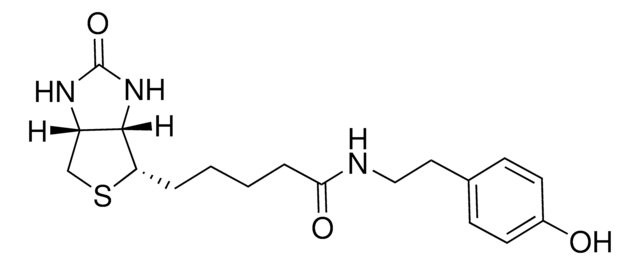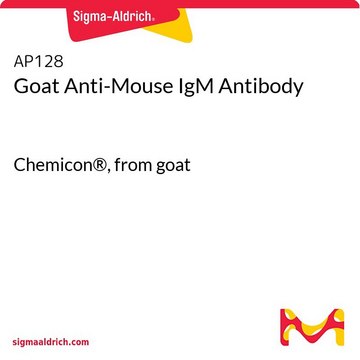AP124B
Goat Anti-Mouse IgG Antibody, biotin-SP conjugate
Chemicon®, from goat
About This Item
Productos recomendados
biological source
goat
Quality Level
conjugate
biotin conjugate
antibody form
affinity purified immunoglobulin
antibody product type
secondary antibodies
clone
polyclonal
species reactivity
mouse
manufacturer/tradename
Chemicon®
technique(s)
ELISA: suitable
western blot: suitable
shipped in
wet ice
target post-translational modification
unmodified
General description
Application
Western blots using enzyme-conjugated streptavidin: 1:10,000-1:100,000.
Immunohistochemistry: 1:500-1:5,000
Flow cytometry: 1:200-1:1,000
Fluorescence Immunohisto/cytochemistry: 1:200-1:1,000
Optimal working dilutions must be determined by end user.
Secondary & Control Antibodies
Whole Immunoglobulin Secondary Antibodies
Physical form
RECONSTITUTION:
Reconstitute with sterile distilled water to match the volume indicated on the vial label.
Storage and Stability
Legal Information
Disclaimer
¿No encuentra el producto adecuado?
Pruebe nuestro Herramienta de selección de productos.
signalword
Warning
hcodes
Hazard Classifications
Acute Tox. 4 Dermal - Acute Tox. 4 Inhalation - Acute Tox. 4 Oral - Aquatic Chronic 3
Storage Class
13 - Non Combustible Solids
wgk_germany
WGK 3
flash_point_f
Not applicable
flash_point_c
Not applicable
Certificados de análisis (COA)
Busque Certificados de análisis (COA) introduciendo el número de lote del producto. Los números de lote se encuentran en la etiqueta del producto después de las palabras «Lot» o «Batch»
¿Ya tiene este producto?
Encuentre la documentación para los productos que ha comprado recientemente en la Biblioteca de documentos.
Nuestro equipo de científicos tiene experiencia en todas las áreas de investigación: Ciencias de la vida, Ciencia de los materiales, Síntesis química, Cromatografía, Analítica y muchas otras.
Póngase en contacto con el Servicio técnico









